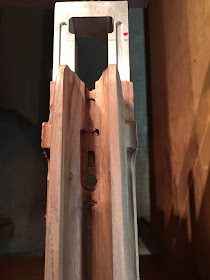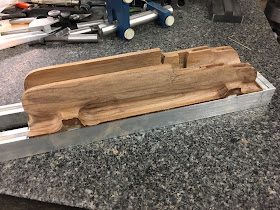Tom Snyder (tpsnyder@mtu.edu) a practicing Long Gun maker out of Hancock Michigan was recently tasked with building a single shot for a client and I received his perfectly glass bedded Farquharson pattern in early October. This Farquharson variant was based on a New Model, Westley Richards 1897 action. Tom had re-barreled this take down action for the classic 450-400 and a second barrel to a 30 caliber Wildcat based off the original 348 Winchester case as the rim diameter and thickness was almost identical to the 450-400 case. Tom then made the rib, sights and figured out how to best handle the take down system that would also include scope mounts. Lots of fiddling to be worked out.
Taking the time to make the pattern for a project you've never attempted can allow you a visual idea of where you want to go stylistically, a road map so to speak. Fitting a rib, the sights and all the requested hardware that the client had envisioned can also allow the client to handle the mock up for fit if he's willing to travel. It's real easy to change the lines on a pattern with splices of wood and or Bondo before you back yourself into a corner with the piece of French walnut. With a pattern you don't have to measure twice and cut once. With a pattern you can cut and then build back all you want.
If you take the time to make a pattern stock it will give you a cosmetic 3 D blue-print before you wonder if you've taken off to much wood as an after thought. Ever been caught in that situation? early on I have
I wonder if I'll ever see other Farquharson stock before I unplug and cover the pantograph for the last time ?


























